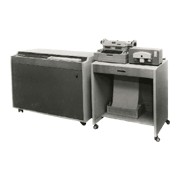After completing the MADIC-I prototype, Matsushita Communication Industrial (today, Panasonic Mobile Communications) studied the marketability of computers at the time and distinctive approaches to entering the market and devised a plan to commercialize the MADIC-II, a transistor-based computer for scientific and engineering computing. The company defined the following target features for the MADIC-II:
(1) The machine is always available at the operator's side; (2) Simple operations so that anyone can easily handle the machine; (3) High reliability; (4) Inexpensive; and (5) Compact.
The development of MADIC-IIA began in May 1959, led by Kinichiro Osugi. After evaluating the MADIC-II prototype, the first commercial MADIC-IIA unit was developed in 1961. The component count was drastically reduced, achieving higher reliability, a smaller footprint, and a lower price, by adopting a binary serial arithmetic methodology and placing the registers on the magnetic drum. The computer was housed in a desktop enclosure for better operability. The hardware included a floating-point arithmetic unit, and the computer came with around 50 scientific and engineering subroutines - such as double-length arithmetic operations, function calculations, linear calculations, and special calculations - to assist programming. Shigeichi Moriguchi from the University of Tokyo also developed SIP (Symbolic Input Program) language and small ALGOL compilers, which greatly improved the machine's usability.
The first MADIC-IIA unit was installed in October 1961 at the Japan Electronics Industry Development Association's Kansai Computer Center, where it was used in a wide variety of calculations. Units with the same configuration were later delivered to the Osaka Medical Center for Cancer and Cardiovascular Diseases (for ECG analysis), Wakayama University, and other locations. Another unit, as an early computer mobile, was installed on a bus, which toured through various areas of Japan giving exhibitions.
Wakayama University has preserved an entire MADIC-IIA system, including its input and output devices.
| MADIC-IIA | |||
|---|---|---|---|
| Initial shipping date | October 1961 |
||
| Arithmetic methodologies | Binary, serial, fixed point, floating point |
||
| Logic elements | 400 transistors 4,000 diodes |
||
| Word configuration | Instruction words - 1 word Numeric words - sign + 33 bits |
||
| Instructions | 31 types, 1+1 addressing, two index registers |
||
| Clock frequency | 200kHz |
||
| Calculation speeds | Fixed point | Floating point | |
Addition and subtraction |
11.7ms | 15.5ms | |
Multiplication |
23.2ms | 23.2ms | |
Division |
23.2ms | 23.2ms | |
| Main memory unit | Magnetic drum (produced by Matsushita Communication) 4,096 words (5.5ms) |
||
| Input and output devices | Printer: One Flexowriter, capable of 10 characters per second Paper tape unit: 200 characters/sec. reading and 50 characters/sec. writing Typewriter: One unit for queries (Option) |
||


